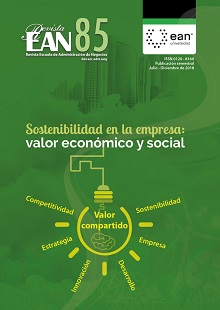Neurodiseño: aplicación de la neurotecnología a la interpretación de las emociones que afectan la decisión de compra online en plataformas e-commerce del sector retail español
Neurodesign: application of neurotechnology to interpret emotions which affect decision making when buying online in platforms such as e- commerce from the spanish retailing sector
Contenido principal del artículo
Resumen
Rev.esc.adm.neg
Entender la esencia psicofisiológica de las emociones se ha convertido en una necesidad imperante en el desarrollo de las estrategias del marketing actual, debido al gran protagonismo que el cliente ha logrado frente a los tradicionales métodos comerciales, donde productos y/o servicios eran el eje principal de actuación. Esta investigación tiene como objetivo identificar e interpretar, a través del uso de herramientas descriptivas y neurocientíficas, el tipo de emociones que experimentan los usuarios al realizar procesos de compra online y cómo estas pueden influir en su decisión final. Se demostró, según pruebas realizadas, que factores emocionales y de ergonomía web —diseño, usabilidad, seguridad— influyen directamente en la decisión de compra del consumidor
Detalles del artículo
Referencias (VER)
Aspinall, P.; Mavros, P.; Coyne, R., y Roe, J. (2015). The urban brain: Analysing outdoor physical activity with mobile EEG. British Journal of Sports Medicine, 49(4) 272-276.
Bai, Y.; Yao, Z.; Cong, F., & Zhang, l. (2015). Event-related potentials elicited by social commerce and electronic-commerce reviews. Cognitive Neurodynamics, 9(6):, 639-648.
Citrin, A.; Stern, D.; Spangenberg, E., y Clark, M. (2003). Consumer need for tactile input. An Internet retailing challenge. Journal of Business Research, 56(11):, 915-922.
Confederación española de personas con discapacidad física y orgánica – Cocemfe. (2016). Observatorio de la accesibilidad. Recuperado de https://www.observatoriodelaaccesibilidad.es/accesibilidad/accesibilidad/definicion/
Cooper, A.; Reimann, R. y Cronin, D. (2014). About face: The essentials of interaction design. 4th edition. John Wiley & Son.
Emotiv. (2016). Página web oficial. (online) http://bit.ly/EMOTIV_2016. (consultado: 23 de noviembre de 2016).Faculty of science and technology, The University of the West Indies.
Galeano, R. (2008). Diseño centrado en el usuario. Revista Q, 2(4): 1-15.
González, M. (2015). Experiencia de cliente. Madrid: LID Editorial.
Gottlieb, B. (2000). Does Group-Shopping Work? The economics of mercata and mobshop. Slate. Recuperado de http://www.slate.com/articles/briefing/articles/2000/07/does_groupshopping_work.html
Guibing, G., y Elgendi, M. (2013). A new recommender system for 3D e-commerce: An EEG based approach. Journal of Advanced Management Science, 1(1) 61-65.
Hausel, H.G. (2008). Brain view: Warum kunden kaufen. Stuttgart: Rudolf Haufe Verlag.
International Organization for Standardization (1998). Norma ISO. 1998. ISO/IEC 9241-11
Kamzanova, A.; Matthews, G.y Jakupov, S. (2011). EEG indices to time-on-task effects and to a workload manipulation (cueing). International Journal of Social, Behavioral, Educational, Economic, Business and Industrial Engineering, 5(8):, 928-931.
Kuan, K.; Zhong, Y., y Chau, P. (2014). Informational and normative social influence in group-buying: Evidence from self-reported and EEG data. Journal of Management Information Systems, 30(4):, 151-178.
Mahmood, A.; Guo, B., y Sismeiro, C. (2016). Choice overload or time stress: What determines purchase decisions for airline tickets? Advances in Consumer Research., 10 p.
Maskeliunas, R.; Martisius, I.; Damasevicius, R., y Vasiljevas, M. (2016). Consumer-grade EEG devices: Are they usable for control tasks? PeerJ, 4:, e1746.
Ranganathan, C., y Ganapathy, S. (2002). Key dimensions of business to consumer web sites. Information & Management, 39(6):, 457-465.
Simone, l., y Nikov, A. (2012). Emotion-oriented e-commerce. In: UWI Computing Forum 2013. Fostering Collaboration in ICT Research and Development. Kingston, Jamaica.
Sourina, oO., y lLiu, yY. (2015). A fractal-based algorithm of emotion recognition from EEG using arousal-valence model. Nanyang Technological University Papers, 1-6.
Ting-peng,, l. y Hung-jen, L. (2002). Effect of store design on consumer purchases: An empirical study of on-line bookstores. Information & Management, 39(6):, 431-444.
Zou, P.; Yu, B., y Hao, Y. (2011). Does the valence of online consumer reviews matter for consumer decision making? The moderating role of consumer expertise. Journal of Computers, 6(3), 484-488.
Descargas
Datos de publicación
Declaraciones de autoría
- Sociedad académica
- Universidad Ean
- Editorial
- Universidad Ean









